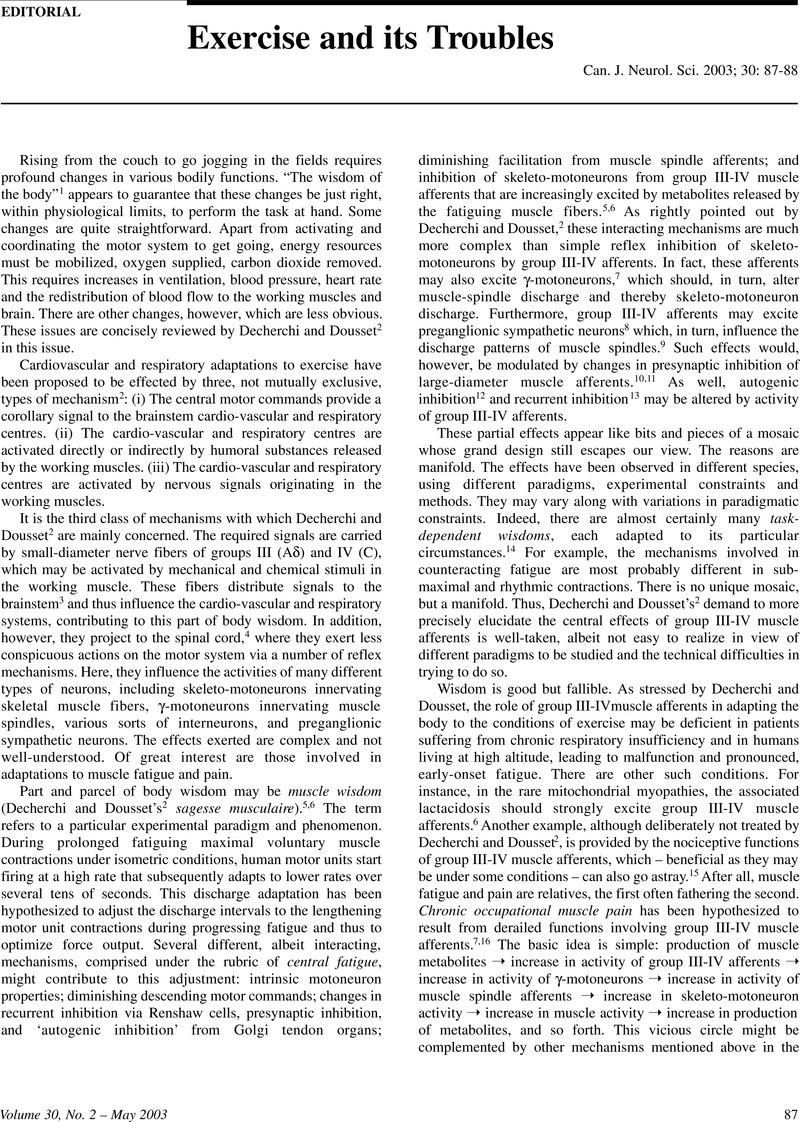No CrossRef data available.
Article contents
Exercise and its Troubles
Published online by Cambridge University Press: 16 December 2016
Abstract
An abstract is not available for this content so a preview has been provided. As you have access to this content, a full PDF is available via the ‘Save PDF’ action button.

- Type
- Editorial
- Information
- Copyright
- Copyright © The Canadian Journal of Neurological 2003
References
REFERENCES
2.
Decherchi, P, Dousset, E. Le rôle joué par les fibres afférentes métabosensibles dans les mécanismes adaptifs neuromusculaires. Can J Neurol Sci
2003; 30: 91–97.Google Scholar
3.
Maisky, VA, Pilyavskii, AI, Kalezic, I, et al. NADPH-diaphorase activity and c-fos expression in medullary neurons after fatiguing stimulation of hindlimb muscles in the rat. Autonomic Neurosci Basic Clin
2002; 101: 1–12.CrossRefGoogle ScholarPubMed
4.
Pilyavskii, AI, Maisky, VA, Kalezic, I, et al. c-fos Expression and NADPH-d reactivity in spinal neurons after fatiguing stimulation of hindlimb muscles in the rat. Brain Res
2001; 923: 91–102.Google Scholar
5.
Gandevia, SC. Spinal and supraspinal factors in human muscle fatigue. Physiol Rev
2001; 81:1725–1789.CrossRefGoogle ScholarPubMed
6.
Windhorst, U, Boorman, G. Overview: potential role of segmental motor circuitry in muscle fatigue. In: Gandevia, SC, Enoka, RM, McComas, AJ, Stuart, DG, Thomas, CK (Eds) Fatigue. Neural and Muscular Mechanisms. New York London: Plenum Press, 1995;241–258.CrossRefGoogle Scholar
7.
Johansson, H, Sjòlander, P, Djupsjòbacka, M, Bergenheim, M, Pedersen, J. Pathophysiological mechanisms behind work-related muscle pain syndromes. Am J Ind Med Suppl 1999; 1: 104–106.3.0.CO;2-6>CrossRefGoogle Scholar
8.
Sato, A, Sato, Y, Schmidt, RF. The impact of somatosensory input on autonomic functions. Rev Physiol Biochem Pharmacol
1997;130: 1–328.CrossRefGoogle ScholarPubMed
9.
Roatta, S, Windhorst, U, Ljubisavljevic, M, Johansson, H, Passatore, M. Sympathetic modulation of muscle spindle afferent sensitivity to stretch in rabbit jaw closing muscles. J Physiol (Lond) 2002; 540.1: 237–248.Google Scholar
10.
Pettorossi, VE, Della-Torre, G, Bortolami, R, Brunetti, O. The role of capsaicin-sensitive muscle afferents in fatigue-induced modulation of the monosynaptic reflex in the rat. J Physiol (Lond) 1999; 515:599–607.CrossRefGoogle ScholarPubMed
11.
Rossi, A, Decchi, B, Ginanneschi, F. Presynaptic excitability changes of group Ia fibres to muscle nociceptive stimulation in humans. Brain Res
1999; 818: 12–22.Google Scholar
12.
Rossi, A, Decchi, B. Changes in Iβ heteronymous inhibition to soleus motoneurones during cutaneous and muscle nociceptive stimulation in humans. Brain Res
1997; 774:55–61.Google Scholar
13.
Windhorst, U, Meyer-Lohmann, J, Kirmayer, D, Zochodne, D. Renshaw cell responses to intra-arterial injection of muscle metabolites into cat calf muscles. Neurosci Res
1997; 27: 235–247.Google Scholar
14.
Enoka, RM. Mechanisms of muscle fatigue: central factors and task dependency. J Electromyogr Kinesiol
1995; 5: 141–149.CrossRefGoogle ScholarPubMed
15.
Mense, S. Nociception from skeletal muscle in relation to clinical muscle pain. Pain
1993; 54: 241–289.CrossRefGoogle ScholarPubMed
16.
Johansson, H, Sojka, P. Pathophysiological mechanisms involved in genesis and spread of muscular tension in occupational muscle pain and in chronic musculoskeletal pain syndromes: a hypothesis. Med Hypotheses
1991; 35: 196–203.Google Scholar
17.
Baranauskas, G, Nistri, A. Sensitization of pain pathways in the spinal cord: cellular mechanisms. Progr Neurobiol
1998; 54: 349–365.CrossRefGoogle ScholarPubMed
18.
Coderre, TJ, Katz, J. Peripheral and central hyperexcitability: differential signs and symptoms in persistent pain. Behav Brain Sci
1997; 20: 404–419.CrossRefGoogle ScholarPubMed


